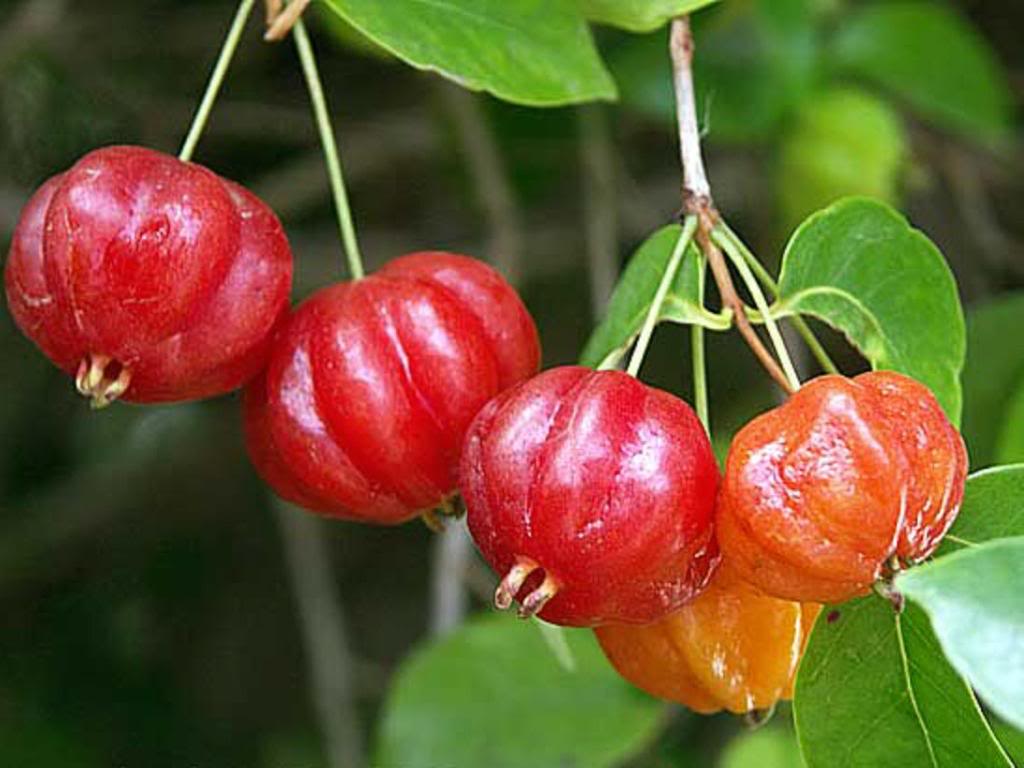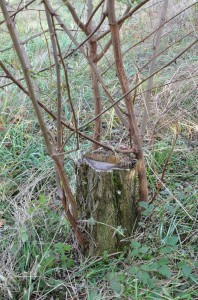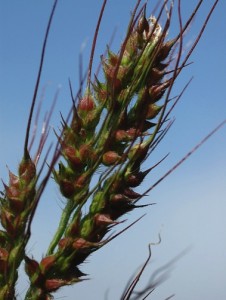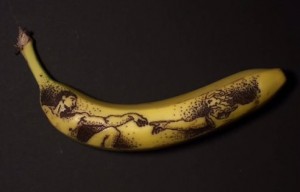There is Ferrari red, with a lot of orange tones. Then there is blood red, with blue notes as they say. You want your Surinam Cherries (Eugenia uniflora) blood red, even darker than the left one above. If you were to eat the yellowish one on the lower right your mouth would be insulted. It might be insulted anyway as not everyone likes the taste of the Surinam Cherry. You’ll find it acceptable, or not, and they are in full fruit locally.
From Suriname but not cherries these pumpkin-looking fruit are closely related to the Simpson Stopper and its iffy kin. I say “iffy” because this is a group of shrubs that changes genera often and their flavor is not mainstream, similar to eating a sweet orange rind, or near that. Some people do not like the flavor of the entire group. They were fruiting heavily in south Florida three weeks ago but aren’t quite ready yet in north Florida. Suriname cherries are not native but have become naturalized and are a familiar sight not only in the wild but in landscaping as well. They used to be planted for hedges and if not maintained closely will grow into tall, wide ambitious shrubs. The fruit is edible out of hand when ripe — remember, blood red — and can be made into jelly, pies and wine. There is also a cultivar that is black when ripe.
Firethorns are putting on berries. In northern climates the Firethorn (Pyracantha coccinea) fruits in the summer and fall. Here in the Deep South we get two seasons of red berries, early summer and late fall. An escaped ornimental they’re planted for their showy weeping branches of bright red berries, which do not go unnoticed by the birds. Currently the shrubs are putting on bunches of green berries that resemble rosehips. Once ripe the berry’s pulp is edible but not the seeds. Like many members of this greater family the seeds contain a small amount of cyanide. A few seeds won’t harm you but a cupfull could kill. To read about the Firethorn click here.
Botany builder #21: Coppicing (COP-pis-sing) is a form of woodland management. Trees are cut back on a regular basis (annually to every 15 years) to encourage growth of numerous adventurous shoots from the base. A resulting thicket is sometimes called a copes or a coppice. Usually the young wood is harvested for firewood, charcoal burning, fencing et cetera. Coppices are young and tender. With some species, such as Basswood or Sumacs, coppicing provides more edibles in the spring time. With the Basswood (Tilea american) it produces abundant edible young leaves and cambium (inner bark.) With Sumac (such as Rhus copalina) it provides shoots that can be peeled and eaten raw or cooked. Commonly coppiced species in North America include oak, willow, ash, chestnut, hazel, sycamore, hornbeam and black locus. Conifers do not coppice well with the exceptions of the coastal redwood (Sequoia sempervirens) and the monkey puzzle tree (Araucaria araucana.) One tree I coppice annually is the Moringa. It’s a species that loves to live and can easily grow 12 feet a year. By coppicing I keep it low and all its edible parts readily available.
Memorial Day and Tropical Storm Beryl kept my foraging classes to one this past weekend, but that’s okay. Have to have a day off now and then. We rummaged around Mead Garden in Winter Park. So far this year the Groundnuts (Apios americana) I’ve found in class have been small. Water fluctuations have impacted wetland plants. One that is managing to seed forth is Barnyard Grass, which is totally misnamed. It might grow in a barn yard right under a gutter spout. Barnyard grass likes damp to wet soil. It’is a grain that can be used like wheat. To read more about the barnyard grass click here.
Foraging Classes:
Saturday, June 2nd, John Chestnut State Park: 2200 East Lake Road, Palm Harbor, FL 34685.
Sunday, June 3rd, Bayshore Live Oak Park, 23157 Bayshore Rd., Port Charlotte, FL 33980.
Saturday, June 9th, Wickham Park: 2500 Parkway Drive, Melbourne, FL 32935-2335.
Sunday, June 10th, Dreher Park, 1310 Southern Blvd., West Palm Beach, 33405, 9 a.m.
Saturday June 16th, Mead Garden, 1500 S. Denning Dr., Winter Park, FL 32789, 9 a.m.
Sunday June 17th, Spruce Creek Park, 6250 Ridgewood Ave. Port Orange, FL. 32127.
Visit the Green Deane Forum! More than 5,000 posts on 1,000 topics, some 2,000 views a day and 500 members. Got a plant you can’t identify? Post it to Green Deane Forum’s UFO board, Unidentified Flowering Objects. Exchange recipes, find some seeds you want, ask questions of more experienced foragers. Learn about foraging. To visit the forum click here.
HOW TO TATTOO A BANANA: If you can’t eat all the bananas you grow you can turn them into art. Makes sense. In a society where nearly everything is throw away now there’s throw away food art. Such art, we are told, also does not use what some considered bad for the environment such as colors made of toxic metals. A book is being released this week on how to tattoo a banana, And here’s a link to see how this banana was tattood. (Be prepared for an ad and some loud music.) To read more about foraging for bananas click here.
THIS WEEK’S “I HATE BICYCLES AWARD” GOES TO: The principal of Kenowa Hills High School, Walker, Michigan.
Sixty seniors, who wanted in their own words, to do something positive, rode their bicycles to school on the next to the last day of classes to empasize environmental concerns, global warming et cetera. They had a police escort and the mayor with them. He even bought them doughtnuts. The principal, Katie Pennington, was not pleased and despite having power over them for only one more day managed to find a punishment. Caught on cellphone she was recorded saying: “…Get your butts home. You’re not participating in senior walk today.” There was also the threat of not letting them attend graduation. School officials, however, have since backed off. Zero tolerance is intolerance.
To donate to the Green Deane Newsletter click here.








Looks like we’re on for June 3rd in Port Charlotte? Hope so because I’m looking forward to knowing more about my environment.
I wonder why the teacher objected? I would think they should have been praised.
Come on Dean, when you going to come to Canada????? I always direct my students to your site!!!